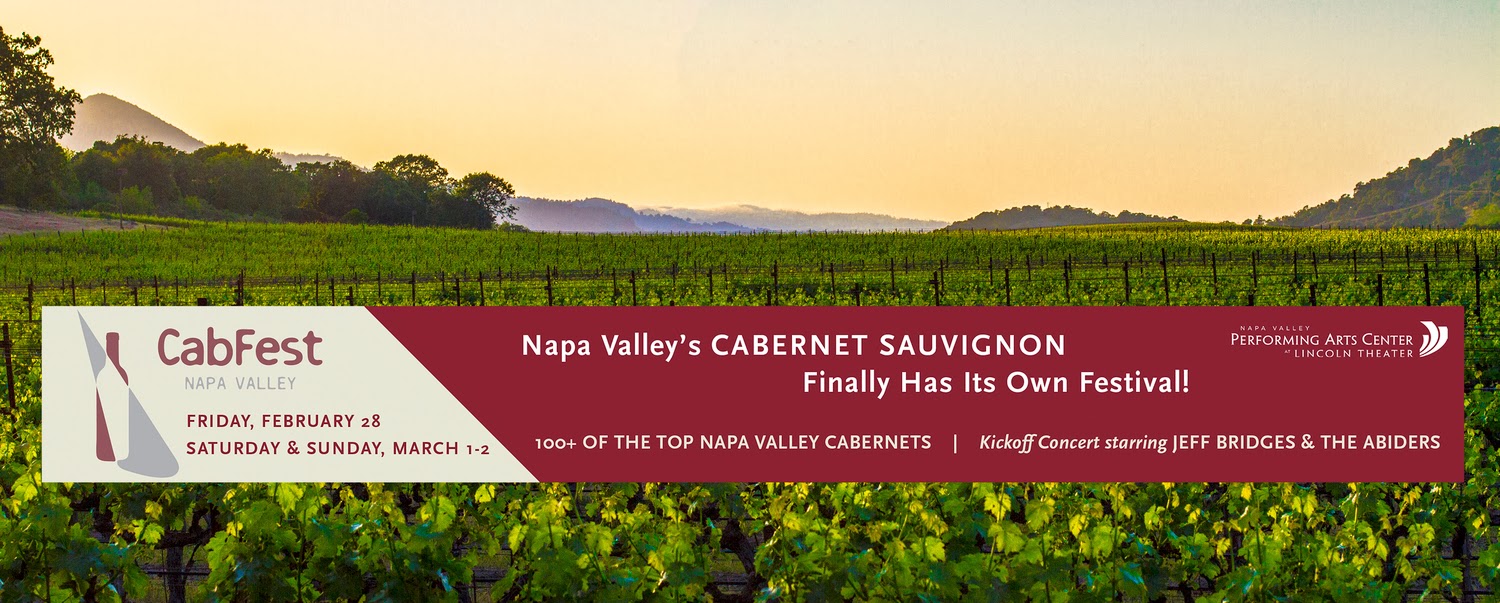CabFestNV
2014
Napa Valley’s
legendary Cabernet Sauvignons finally have their own festival! CabFestNV
is a three-day celebration that will appeal to both the expert and the novice,
featuring more than 100 of the biggest names in the wine industry as well as
the best of the boutiques. Through current and library wine tasting,
interesting and informative panels, educational and interactive seminars and
keynote presentations, CabFestNV will spotlight the many facets of Cabernet
Sauvignon’s complexity and mystique. But there is much more to CabFestNV than
just enhancing the appreciation and appeal of Cabernet Sauvignon. CabFestNV is
out to also prove that seriously good wine needn’t take itself too seriously…
which means the weekend will also be laced with great music from rock to
classical, great food, and fun and fabulous events for all those who attend.
Michael Madden (Chief
Executive),
Lincoln Theatre
Michael Madden also serves as the Executive Director of the Napa
Valley Performing Arts Center at Lincoln Theater. His keen insights into
Lincoln Theater operations, his knowledge of the local marketplace and his
informed perspective on what it will take to make the venue successful, make
him uniquely qualified to fulfill the mission and objectives of the Lincoln
Theater Foundation and its Napa Valley Performing Arts Center at Lincoln
Theater. In his career, Madden successfully built and managed businesses
with over 200 employees, he gained invaluable experience overseeing major
business restructurings and he developed publishing campaigns for entertainment
giants such as Sony Pictures, Fox, Lucas Film, Quincy Jones, Suze Orman and
James Cameron.
Winemaker Celia Welch
Corra Wines
Celia Welch, consulting
winemaker to some of Napa Valley’s finest Cabernet Sauvignon estates, is proud to welcome you to her own endeavor,
CORRA.
Grapes from three prime vineyards in three of Napa Valley’s premium growing regions, Oakville, Rutherford and Pritchard Hill, combine to create the powerful yet elegant Corra Cabernet Sauvignon.
Corra, a Celtic deity representing prophecy, symbolizes this small brand’s forward-looking perspective. Showing herself on earth in the form of a crane, Corra takes wing and lifts her shadow to life.
Grapes from three prime vineyards in three of Napa Valley’s premium growing regions, Oakville, Rutherford and Pritchard Hill, combine to create the powerful yet elegant Corra Cabernet Sauvignon.
Corra, a Celtic deity representing prophecy, symbolizes this small brand’s forward-looking perspective. Showing herself on earth in the form of a crane, Corra takes wing and lifts her shadow to life.
Celia Welch’s first
interaction with grapes was under the huge oak tree in her backyard in Southern
Oregon, where her siblings and she plucked grape berries from stems for their
father, an avid wine collector and home winemaker. Her parents also included
the family on trips through Napa and Sonoma in the early sixties, and, like
most visitors, she was entranced with the beauty of the rolling vineyards.
In 1982 with a degree in
Enology earned at UC Davis in her back pocket, she set out to take a peek at a
few wine regions. Her travels took her to the Pacific Northwest, the East
Coast, and to New Zealand. She worked harvest in the Barossa Valley of Australia,
and then settled in the Napa Valley to refine her craft.
Celia had reached a fork in
her career path in the early nineties, and she chose to focus on independent
wineconsulting. The wines she has made create a microcosm of Napa Valley. She
has made wine from vineyards on Mt. Veeder, Atlas Peak, and Howell Mountain to
those in Carneros, and from benchland vineyards from St. Helena to Napa.
In 2004 came the idea and the
challenge of founding Corra. It was not easy to find vineyard sources with
top-quality fruit, a winery with a bit of space to spare for barrels, and a
strong team of individuals with experience in different aspects of the wine
business from grapevines to websites. The results of these efforts have been
tremendous; well-received wines and a project that has lead to information- and
idea-sharing for everyone involved.
Jeff Gargiulo
Gargiulo Vineyards
As a lifetime farmer, Jeff
Gargiulo has always been passionate about the land and agricultural, and today
that passion is focused on the joys of grape growing and fine wine making. 30
years ago though, he and his wife Valerie only dreamed of one day building a
premier wine estate. That dream took shape in the early 1980s when Jeff and
Valerie and their young family traveled to Napa Valley to visit Valerie's
cousins, Barney and Belle Rhodes. Napa Valley icons, Barney and Belle Rhodes
had been in the Napa Valley since the late 1960s growing grapes in Rutherford
at Bella Oaks Vineyard. Jeff and Valerie were inspired by their cousin’s Napa
Valley lifestyle and confident that with their help and Jeff’s agricultural
knowledge they would make some of the finest wines in the world. Twelve years
later and with countless hours of coaching from Barney and Belle, Jeff and
Valerie purchased their first vineyard in Oakville, Napa Valley, Money Road
Ranch in 1992. Seven years later they purchased their second Oakville property,
575 ovx.

From the beginning, the
Gargiulo’s committed themselves to creating a world class Cabernet Sauvignon
wine estate. From his years spent farming, Jeff Gargiulo, knew that if he
didn't start with the very best land, he could never expect to grow the best
grapes. For this reason, the Gargiulo's chose Oakville to establish their
namesake winery. Then, like today, Oakville was considered to be amongst the
preeminent places to grow Cabernet Sauvignon in the world. The very first
vintage of Gargiulo Vineyards Cabernet Sauvignon was 2000, and since then
Gargiulo Vineyards has quietly taken its place among the most highly regarded
Cabernet Sauvignon producers in Napa Valley. Not ones to rest on their laurels,
Jeff, Valerie, daughter, April and the entire Gargiulo Vineyards’ team continue
to strive to make Gargiulo wines the most pure and breathtaking expressions of
their two esteemed Oakville vineyards.































